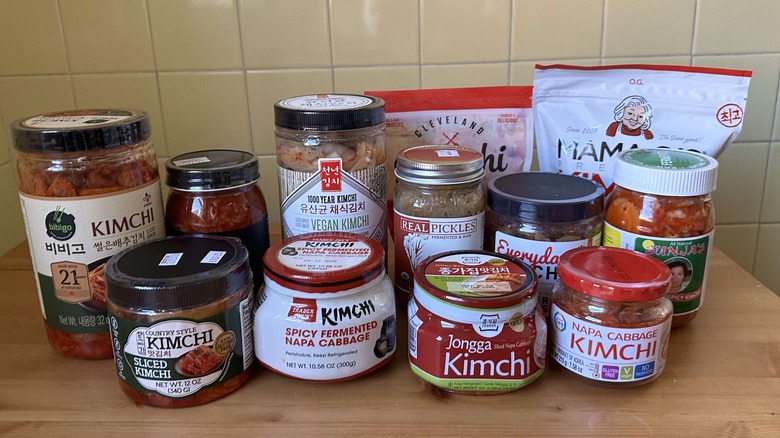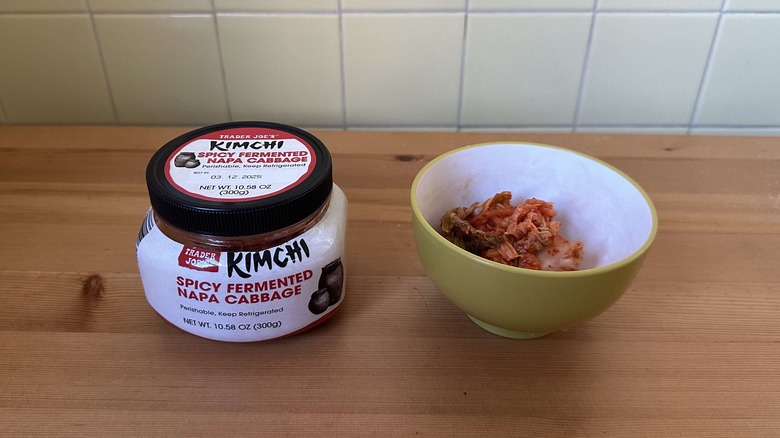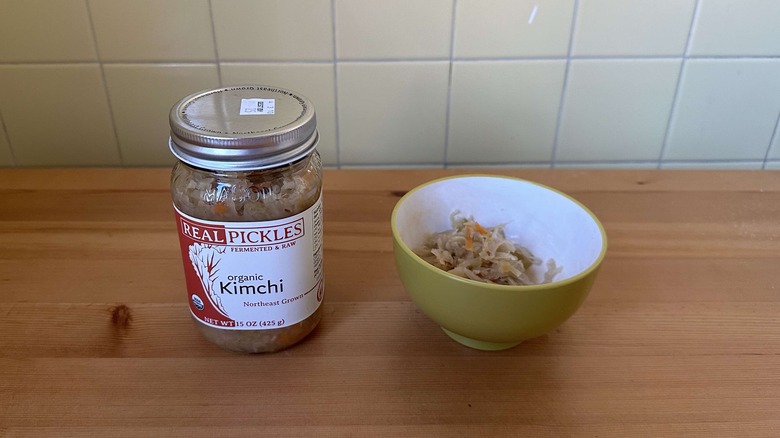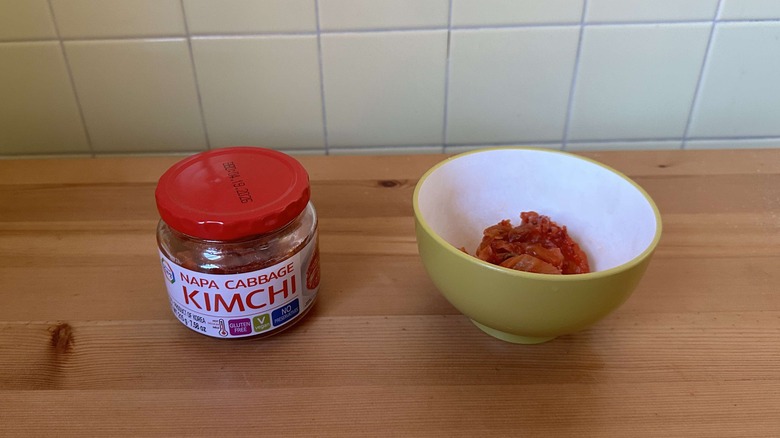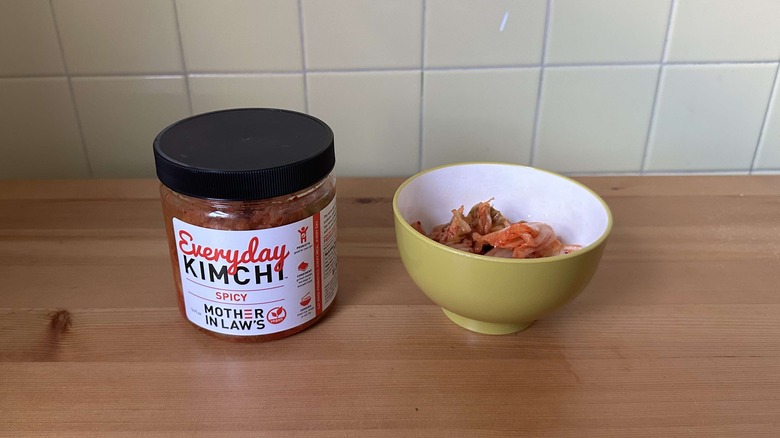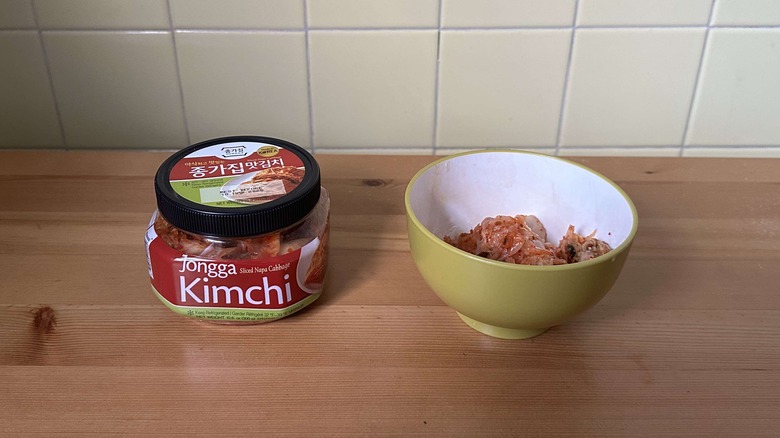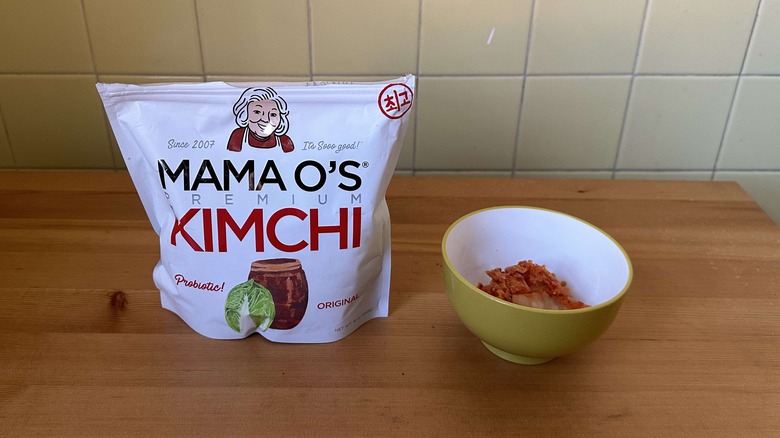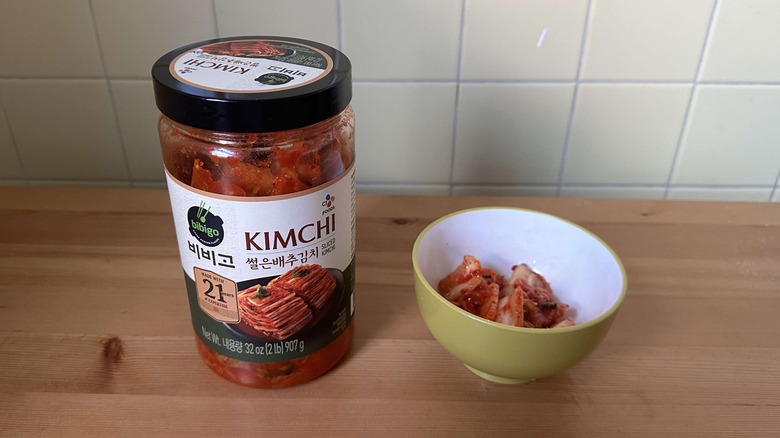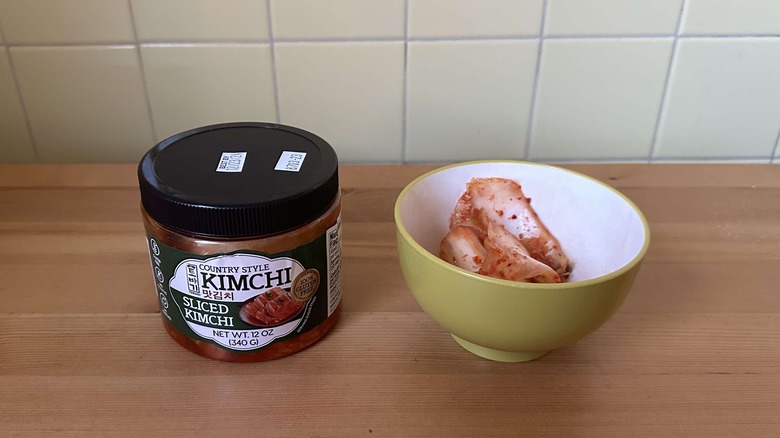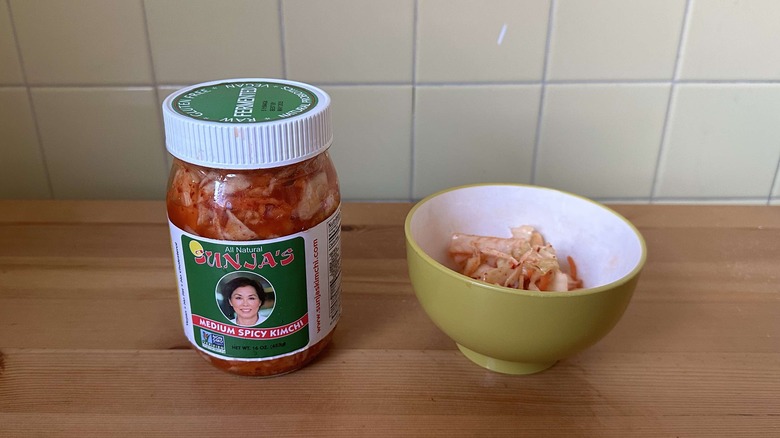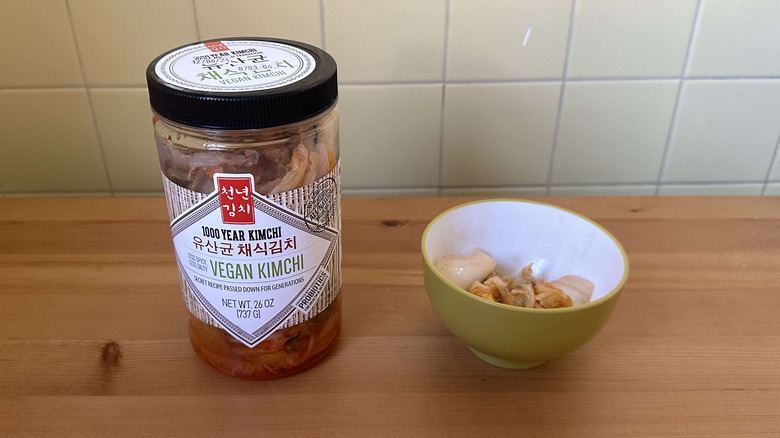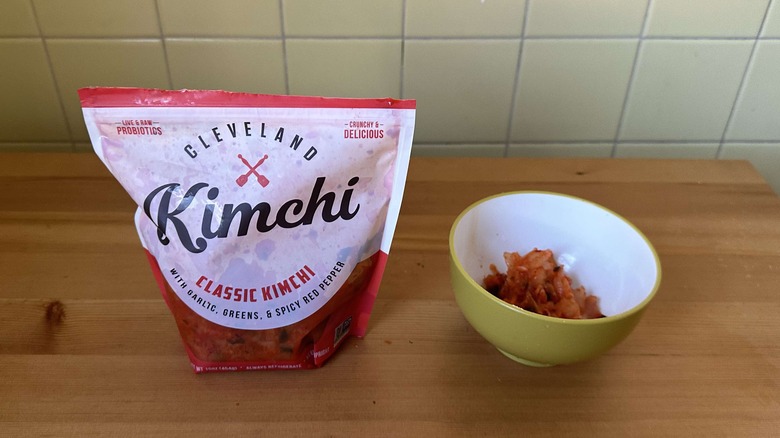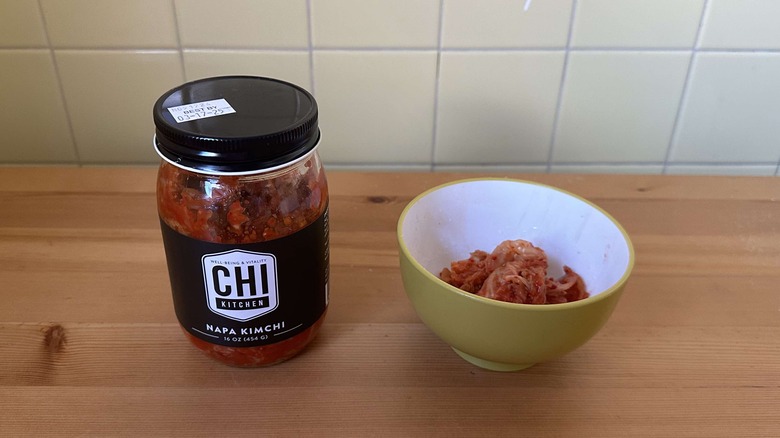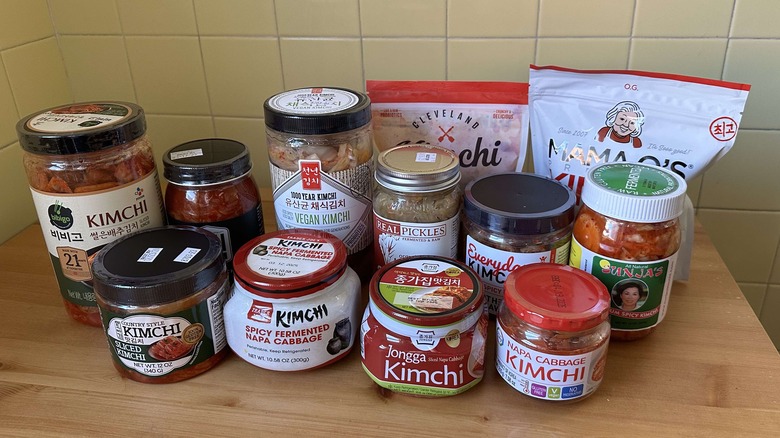The Best Kimchi Brands Ranked
We may receive a commission on purchases made from links.
Kimchi: It's the salty, sometimes spicy, supremely flavorful Korean fermented cabbage dish that's delicious both on its own as a side dish as well as incorporated into other dishes, like sundubu jjigae and kimchi fried rice. Although it's surprisingly simple to make kimchi at home, you don't have to go through all the work of flavoring and fermenting your own cabbage every time you have a craving for the crunchy, spicy dish. There's an excellent chance you'll find a variety of different kimchi brands at your local grocery store, and you're likely to have even more options if you live near an Asian market.
But as I discovered — when I tasted my way through 12 different kimchi brands — not all kimchi is created equally. There are different types of kimchi, but I mainly focused on sliced (as opposed to whole-leaf) baechu kimchi for this article. Of course, kimchi quality assessments are quite subjective, and as someone who didn't grow up eating kimchi at home, my preferences may be different from those of other kimchi lovers out there, although I am an avid kimchi consumer. Regardless, I ranked each of these brands, starting from my least favorite to the best of the bunch, according to both flavor and texture, prizing highly concentrated flavors and crunchy textures to give you a better idea of which kimchi brands you may want to try next. Hopefully, this ranking will point you in the direction of your go-to kimchi brand.
12. Trader Joe's spicy fermented napa cabbage kimchi
I want to start by saying that I am not a Trader Joe's hater by any means. I visit the store on a regular basis, and I'm a big fan of many of the chain's products. But generally speaking, Trader Joe's Asian food selection can be ... lacking, to put it nicely. And that certainly holds true for the brand's spicy fermented napa cabbage kimchi. Most of the kimchi brands on this list are at least decent, if not downright delicious. Trader Joe's kimchi, on the other hand, is definitely not.
Kimchi is an undeniably funky food, which is a huge part of its appeal. This version from Trader Joe's nixes the funk completely, leaving you with a container of deeply acidic, slightly spicy fermented cabbage that doesn't really have any additional complexity to boast. The unbalanced flavor leaves you wondering if you actually ate real kimchi. Add in the fact that the cabbage is rather soft and lacking that signature crunch, and it's no wonder why it earned the last spot in this ranking. Personally, I'm going to make it my mission to avoid Trader Joe's kimchi.
11. Real Pickles organic kimchi
Koreans aren't the only ones who have discovered that fermented cabbage can be extremely delicious. Sauerkraut, which was brought to Europe by the Chinese, also features that salty, fermented flavor that we know and love. Although sauerkraut is similar to kimchi, its flavor profile is quite different, and when you're specifically buying kimchi, you probably don't want a product that tastes like sauerkraut. That's why I was disappointed when I tried Real Pickles' organic kimchi.
This stuff isn't necessarily bad, per se, but it definitely seems to lean more in the direction of sauerkraut than it does kimchi. It doesn't have much spice, which is apparent by its lack of red color. The prominent flavor you'll taste is ginger, which is so strong that it almost obscures the other flavors going on. The brand admits that it used Korean kimchi as an inspiration and that there are more classic versions out there, so you may be better off seeking those varieties out if you're looking for a traditional-tasting kimchi.
10. Surasang napa cabbage kimchi
If you like super spicy kimchi, then Surasang napa cabbage kimchi is probably not the product for you. It's missing that pronounced spice that's so easy to love in kimchi. That being said, if you're looking for a milder version of the dish, then this brand is one to check out. Plus, it's vegan, unlike many other brands of kimchi that are made with anchovies and other seafood-centric ingredients. However, when it comes to texture, Surasang's kimchi falls flat. This stuff is especially soft and doesn't offer the crunchy texture you might expect from cabbage. And I'm not just talking about those malleable outer leaves, either. Even the hard, white parts of the cabbage are super soft.
For those who are just buying kimchi as an addition to a soup they're making, Surasang's offering may be a good option. However, if you're the type of person who really craves that crisp texture when it comes to kimchi, then you may want to search for another brand on the kimchi market.
9. Mother in Law's Everyday Spicy Kimchi
Every brand of kimchi has a slightly different flavor, with some varieties honing in on the spice while others boast an umami quality, for example. But when it comes to Mother in Law's Everyday Spicy Kimchi, the flavor that's likely to stand out the strongest is acidity. The acidity in this kimchi is absolutely searing, and it's enough to leave you feeling taken aback if you're used to other kimchi brands. For those who really love super bright acidity, this may be a good product to check out. In my opinion, though, the effect made the flavor of this kimchi feel too unbalanced for me to truly enjoy. And when you consider it's missing a noticeable spiciness, that lack of balance seems even more highlighted.
Additionally, you'll have to contend with the less-than-crunchy texture. Again, this may not be a dealbreaker for some, but it's not ideal when you're trying to capture that crispy texture that cabbage is known for. This certainly wasn't the worst kimchi of the bunch that I tried, but it's one that I probably won't seek out specifically again.
8. Jongga sliced napa cabbage kimchi
Honestly, kimchi is not one of the cheapest ingredients you'll find on store shelves. All too often, it is exceptionally expensive, particularly if you're not buying from an Asian market. If you're looking for a more affordable brand out there (depending on where you shop, of course), you may want to turn to Jongga sliced napa cabbage kimchi. Plus, it boasts some actual heat, so anyone who enjoys kimchi specifically for its spicy flavor profile should be able to get behind this brand.
Besides that spice, though, when it comes to flavor, Jongga isn't my favorite. This kimchi tasted much different than the other brands I tried, with an almost sweet note that cut through the bright acidity. It's quite mild, which isn't necessarily bad, but it lacks the pronounced flavor concentration of the best kimchis. That milder flavor, though, might make this brand more accessible to those who don't already love kimchi. If you can find it at your local grocery store, it may be worth a try, but there are other more interesting brands to seek out as well.
7. Mama O's premium kimchi
Here's another kimchi brand that's not really delivering when it comes to a strong, pronounced flavor. Mama O's premium kimchi comes packaged in an appealing bag instead of a jar, which drew me to the brand immediately. Upon actually opening that bag and trying some of the kimchi inside, though, I was slightly less enthusiastic. The main complaint I have about this brand is the product's wateriness. With some brands of kimchi, you'll notice that the cabbage leaves are soaking in a bold, intensely hued red liquid, which gives the kimchi its enjoyable flavor.
That bright red liquid is missing here, though. Rather, you have a milder, more watery liquid you're working with. Again, this isn't necessarily a bad thing — when you want a milder kimchi that doesn't deliver the same kick as some other varieties, Mama O's is a great option. For those who prefer a more concentrated type of kimchi, though, you're better off seeking out another brand the next time you plan on buying the ingredient.
6. Bibigo kimchi
A lot of grocery stores carry Bibigo products, so there's a good chance you can find this kimchi brand at your local grocery store. Although this wasn't one of my favorite brands, I have to admit that it's definitely a solid one. The flavor may not be as strong and as concentrated as I'd prefer, but it's certainly stronger than that of a lot of the other kimchi brands on this list. Even though the acidity and umami notes don't particularly stick out, the kimchi has a lovely spice to it with some actual heat. It's not super spicy, but it's also not for the faint of heart. And while this kimchi may be mostly made with cabbage, you'll also notice some radishes in the mix, which makes for an extra crunch that adds to the textural experience of eating this brand of kimchi.
So, why doesn't it score higher on this ranking? The main problem comes down to the addition of sorbitol, which is a non-sugar sweetener. You can taste that sweetness in the kimchi, and it delivers perhaps too much sweetness. Sure, it's probably meant to balance some of that intense acidity you'll get from this brand, but the result is a saccharine-tasting kimchi that feels more odd than balanced.
5. Tobagi Country Style Sliced Kimchi
If you're on the hunt for a standard kimchi brand that you can go back to time and time again, you may want to check out Tobagi's Country Style Sliced Kimchi. There are so many reasons to love this brand. First of all, the flavor is very nicely balanced. There's that signature acidity plus a fishy, umami note from the addition of ingredients like anchovies. That fishiness may not be for everyone, but I happen to think it's a signature of a particularly tasty kimchi. The spice level here is good, too — it's not overly spicy, but it still delivers the strong heat you might expect from kimchi. Additionally, the kimchi is cut into manageable chunks that you can eat whole or chop up to add to other dishes.
My only complaint about this brand is that it can be a bit watery, particularly if you get too many white, as opposed to green, pieces of cabbage in the jar. Since I've tried this brand many times before, I know it can be hit or miss, so you'll just have to take your chances if you want to try this brand out. Keep in mind that you can find this kimchi in a variety of different-sized jars, which allows you to keep either a little or a lot of kimchi on hand all the time.
4. Sunja's medium spicy kimchi
Have you ever opened a fresh jar of kimchi only for all those juices to fizz and bubble over, creating a bit of a mess in your kitchen? If so, you might assume that the kimchi has gone bad, but that's actually not the case. In fact, fizzing kimchi usually just indicates that it's been fermenting for longer than its non-fizzing counterparts. When I first opened my jar of Sunja's medium spicy kimchi, I immediately noticed an intense fizz that I understood to mean I was in for a treat ... and I wasn't wrong.
This kimchi offered the best texture out of all the different brands I tried. All the pieces of cabbage were actively crunchy, which makes for an undeniably enjoyable textural experience. That's largely because this kimchi uses a lot of those white, crunchy pieces of cabbage. Although I love that pronounced crunch, I also wish there were more softer, greener pieces of cabbage in the mix to really keep things interesting. But considering that this vegan kimchi tasted so fresh, so alive, it's safe to say that it's earned its spot in the top four brands on this ranking.
3. 1000 Year Kimchi vegan kimchi
Several of the kimchi varieties I tried in this ranking are vegan, which is great for people who love the flavor of kimchi but want to stay away from animal products. If you fall into that camp, one of the best varieties of kimchi to check out is 1000 Year Kimchi vegan kimchi. This brand also offers a lovely texture, with a nice mix of both crunchy pieces and softer, more pliable slices of cabbage.
When it comes to flavor, though, this kimchi is noticeably different from the other brands I tried for this ranking. The flavor is significantly lighter and milder than the other varieties, with a less perceptible spiciness than you would probably expect from kimchi. It's also lacking that intense saltiness you'll find with some brands. Although I'd personally prefer a more concentrated flavor profile, I will admit that this stuff is really, really delicious. It shines primarily for its texture, but for those who want to add just a little extra flavor to their kimchi-centric dishes, this brand offers a delicious option.
2. Cleveland Kitchen classic kimchi
Cleveland Kitchen offers bagged vegan kimchi with a lot more flavor intensity than some of the other brands on this list. The most noticeable flavor in this product, I found, was garlic. That garlicky flavor is ultra-pronounced, which should make all garlic lovers swoon with joy. It boasts a solid level of spiciness, with just enough kick to keep things interesting but not so much that you find yourself overwhelmed with spice upon your first bite.
The texture of the cabbage itself is solid here as well, although the pieces of veggies are cut into especially small pieces. This doesn't feel ideal for snacking since you don't get those big, satisfying bites you might be used to from kimchi. However, it does make this brand particularly great for times when you want to use kimchi as an add-in or topping. For example, it would be fantastic in kimchi fried rice. You could also use this variety of kimchi on rice bowls, noodle dishes, and even on a sandwich.
1. Chi Kitchen napa kimchi
Chi Kitchen's napa kimchi is in a particularly well-designed package — I didn't know what I was getting myself into when I first opened the jar. What I found, though, was some deeply delicious kimchi I can't wait to try again. This kimchi had a delicious, extremely concentrated flavor with a bright red color that coats each individual piece of cabbage and the liquid inside the jar as proof. There's definitely some noticeable spice here. With my relatively high spice tolerance, I found it approachable without being too bland. There's also a unique flavor to it, with a bready, yeasty note that I didn't encounter in the other varieties.
The texture here is spot on, too. You have some crunchier pieces with some softer, more supple pieces mixed in. The result is a well-balanced, ultra-flavorful, undeniably delicious kimchi that I plan to keep coming back to again and again. Give it a try if you're looking for a solid kimchi standby you can always depend on.
Methodology
I chose these kimchi brands based on local availability and tried to opt for the original or most generic flavors available to keep as even a playing field as possible. However, many of these brands offer different varieties and flavors. When I tasted these kimchis, I tried each of them straight out of the fridge, so they tasted as cold and as fresh as possible. I ate them on their own, with no other competing flavors to detract from them. The criteria for the ranking is based on flavor, first and foremost, although I also paid particularly close attention to texture as well.
